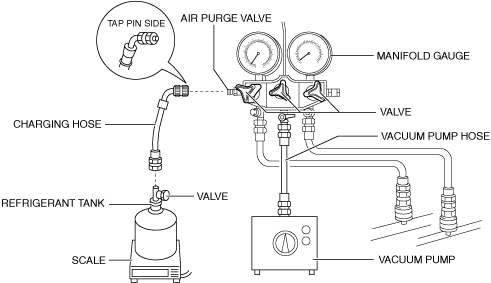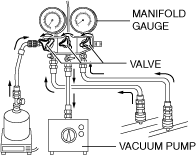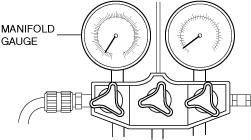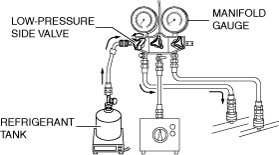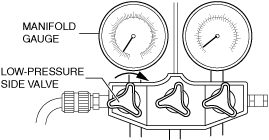REFRIGERANT CHARGING [(US)]
REFRIGERANT CHARGING [(US)]
SM2566248
id0710003001x1
-
Caution
-
• Do not use a different type of refrigerant or charge beyond the specified level. Otherwise, cooling ability will be lowered and the A/C compressor could be damaged.
|
Engine type |
Refrigerant type |
Regular amount of refrigerant (approx. quantity) (g {OZ}) |
|---|---|---|
|
SKYACTIV-G 2.0, SKYACTIV-G 2.5
|
HFC-134a (R-134a)
|
465—515 {16.5—18.1}
|
Charging Recycled HFC-134a Refrigerant
1.Connect a HFC-134a recovery/recycling/recharging device to the vehicle and follow the device manufacturer’s instructions.
Adding Compressor Oil
1.Weigh the compressor oil which is exhausted when collecting the refrigerant.
2.When adding refrigerant, add new compressor oil equivalent in weight to the exhausted amount to the refrigerant cycle.
Charging Preparation
1.Close all the valves of the manifold gauge.
am3zzw00034795
|
2.Close the refrigerant tank valve.
3.Install the manifold gauge set. (See MANIFOLD GAUGE SET CONNECTION.)
4.Connect the vacuum pump hose to the manifold gauge.
5.Connect the tap pin side of the charging hose to the air purge valve of the manifold gauge.
6.Connect the charging hose to the refrigerant tank (no-tap pin side).
7.Place the refrigerant tank on the scale.
8.Connect the vacuum pump hose to the vacuum pump.
9.Perform a evacuation. (See Evacuation.)
Evacuation
1.Open all the valves of the manifold gauge.
am3zzw00034796
|
2.Start the vacuum pump and let it operate for 15 min.
3.Verify that high- and low-pressure side readings of the manifold gauge are at -0.1 MPa {-1 kgf/cm2, -15 psi}.
4.Stop the vacuum pump.
-
Caution
-
• If the manifold gauge valves are left open, vacuum pump oil will backflow into the refrigeration cycle and cause the cooling performance to lower. After stopping the vacuum pump, close the manifold gauge valves immediately.
5.Close all the valves of the manifold gauge.
am3zzw00034797
|
6.Wait for 5 min after stopping the vacuum pump, and perform an airtightness check for the refrigerant system. (See Airtightness Check.)
Airtightness Check
1.Verify that the manifold gauge reading has not changed.
am3zzw00034798
|
-
• If the manifold gauge reading has changed, inspect the refrigerant system following the symptom troubleshooting procedure. (See TROUBLESHOOTING INDEX [FULL-AUTO AIR CONDITIONER].) (See TROUBLESHOOTING INDEX [MANUAL AIR CONDITIONER].)• If the reading has not changed, perform a charging new refrigerant. (See Charging New Refrigerant.)
Charging New Refrigerant
-
Warning
-
• If the refrigerant system is charged with a large amount of refrigerant when inspecting for gas leakage, and if any leakage should occur, the refrigerant will be released into the atmosphere. In order to prevent the accidental release of refrigerant which can destroy the ozone layer in the stratosphere, follow the proper procedures and charge with only a small amount of refrigerant when inspecting for gas leakage.• If charging the system with refrigerant using refrigerant tank, running the engine with the high-pressure side valve open is dangerous. Pressure within the refrigerant tank will increase and the refrigerant tank could explode, scattering metal fragments and liquid refrigerant that can seriously injure you. Therefore, do not open the high-pressure side valve while the engine is running.
1.Open the valve of the refrigerant tank.
am3zzw00034799
|
2.Weigh the refrigerant tank to charge the suitable amount of refrigerant.
3.Open the low‐pressure side valve of the manifold gauge.
am3zzw00034800
|
4.Verify that low-pressure side readings of the manifold gauge is at 0.1 MPa {1 kgf/cm2, 15 psi}.
5.Close the low‐pressure side valve of the manifold gauge.
am3zzw00034801
|
6.Inspect for gas leakage from the piping connection using a gas leak detector or a fluorescent agent-detecting UV black light.
-
• If there is no leakage, go to Step 8.• If there is gas leakage, tighten the piping connection to the specified torque, then go to the next step.
7.Inspect for leakage again.
-
• If there is no leakage after tightening the joint, go to the next step.• If there is refrigerant leakage, inspect the refrigeration system following the symptom troubleshooting procedure. (See TROUBLESHOOTING INDEX [FULL-AUTO AIR CONDITIONER].) (See TROUBLESHOOTING INDEX [MANUAL AIR CONDITIONER].)
-
Warning
-
• Never start the engine while the valve on the high pressure side is open. If the engine is started while the manifold gauge valve on the high pressure side is open, highly pressurized refrigerant could backflow into the refrigerant tanks and cause damage.
8.Open the low‐pressure side valve of the manifold gauge.
am3zzw00034800
|
-
Caution
-
• Never charge refrigerant with the refrigerant tanks upside down. If the refrigerant system is charged with the refrigerant tanks upside down, liquid refrigerant will be charged into the system, and the A/C compressor could become highly pressurized and damaged.
9.Charge with refrigerant until the weight of refrigerant tank has decreased 250 g {8.82 oz} from the amount in Step 2.
10.Close the low‐pressure side valve of the manifold gauge.
am3zzw00034801
|
11.Start the engine and actuate the A/C compressor.
12.Open the low‐pressure side valve of the manifold gauge and charge with refrigerant until the weight of the refrigerant tank has decreased regular amount from the amount in Step 2.
am3zzw00034800
|
-
Caution
-
• Never charge refrigerant with the refrigerant tanks upside down. If the refrigerant system is charged with the refrigerant tanks upside down, liquid refrigerant will be charged into the system, and the A/C compressor could become highly pressurized and damaged.
13.Close the low‐pressure side valve of the manifold gauge.
am3zzw00034801
|
14.Stop the engine.
15.Perform the leak test. (See Leak Test.)
Leak Test
-
Caution
-
• Looking directly at a fluorescent agent-detecting UV black light may cause injury to the eyes. Do not look directly into the light of a fluorescent agent-detecting UV black light.
-
Note
-
• Because fluorescent agents (yellow or light green dye) are in the refrigeration cycle, the leak test can be performed with a fluorescent agent-detecting UV black light.
1.Inspect for gas leakage from the piping connection using a gas leak detector or a fluorescent agent-detecting UV black light.
-
• If there is no leakage, go to Step 3.• If there is gas leakage, tighten the piping connection to the specified torque, then go to the next step.
2.Inspect for leakage again.
-
• If there is no refrigerant leakage, perform the procedure from the evacuation again. (See Evacuation.)• If there is refrigerant leakage, inspect the refrigeration system following the symptom troubleshooting procedure. (See TROUBLESHOOTING INDEX [FULL-AUTO AIR CONDITIONER].) (See TROUBLESHOOTING INDEX [MANUAL AIR CONDITIONER].)
3.Disconnect the quick couplers from the charging valves.
am3zzw00034802
|
4.Install the caps to the charging valves.
